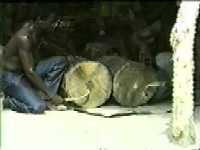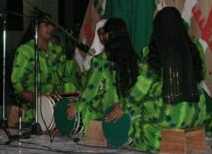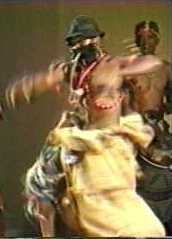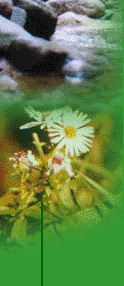|

Drummers in Modern Africa: Dance drumming has
spread to many parts of the world through the slave trade
route.
The original 3 Negro migrants were Marujan, Bilal and
Sangor. The first two had no offspring.
Sangor had three children, Aisa, Ahammad and Unbusheim.
This family grew and today it is said that nearly all
inhabitants of Feridhoo and many in Maalhos are its progeny.
[The author’s mother happens to be the great grand
daughter of Sangor. Her Family line is: Sangor –
Ahammad – Aisa – Dhon Kamana – author’s mother.]
The Negroes of Feridhoo were big and powerful
people. They had typical Negroid features, curly hair,
dark skin and all. It is said that some decades back
most Feridhuans were dark, but with racial mixing over the
years, many light skinned babies were born.
Feridhuans called them ‘fair Negroes’. The majority of today’s
Feridhuans are fair Negroes, but typical Negroes with dark
skin are not uncommon.

Women dance drummers in 21st century
Maldives: There is little doubt that this art form came
from Africa.
Over the years Feridhuans have lost their legendary
strength. In the olden days it was said that a single
angry Feridhuan could overpower 10 men. Outsiders were
afraid of confronting them. But today things have
changed.
Sangor and his companions introduced African
dance drumming to Feridhoo. Dance drumming was centered on
captivating rhythms played on special drums. There were
several different rhythms including fona, maana and ragguda.
Dance drumming soon caught on with the locals and spread to
many other islands of the Maldives including the capital Male.
It survives to this day as ‘bodu beru’ (Dhivehi = big
drum).

Even
modern dance drummers work themselves into a frenzy of ecstasy
Even in modern bodu beru one can see glimpses of the
heady excitement of the African original.
Sometimes as the crescendo mounts drummers beat not just their
own drums but also those of others nearby, all the while
maintaining perfect rhythm using hands and even the head.
It is not unusual for them to injure themselves in the
process. Dancers also shared in this excited mood,
gyrating their way into unconsciousness.
Bodu Beru is accompanied by ‘baburu’
(Negro) songs and dances. These days most songs are in
Dhivehi, but Feridhuans still preserve many original African
songs. Here are the words of a very popular song:
“Kadoodoo kayaavei kadoodoo kaa ayaavei,
Ado yathan boake thanoodei uppani keikei,
Niya negoala bumbaisa,
Ahei lailaka maye bothei,
Ahei lailaka rugunja,
Ahei lailaka muruguja,
Ahei lailaka sikka thibei."
Though today people don’t understand their
meaning, these songs are still extremely popular with the
crowds. Perhaps their rhythm is connected with the pulse
of Feridhuans.
| 



